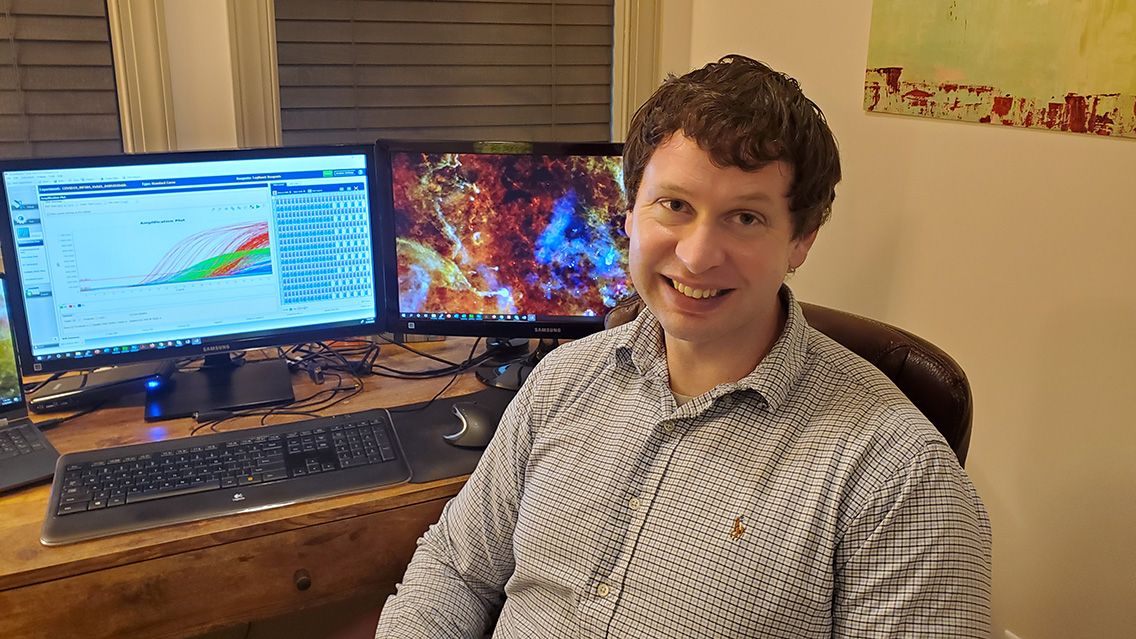Rapid Response Test
One of the key elements in the fight against COVID-19 is accurate and adequate testing. Helping that effort is a team of researchers at LabCorp, headed by Brian Krueger ’05, to support the response to the pandemic.
Most clinical laboratory tests in the U.S. must be reviewed and approved by the U.S. Food and Drug Administration (FDA), which can take six months to a year or longer. However, laboratories can internally develop and confirm the accuracy and performance characteristics of a test – a process called validation – and make the test available to the public as a laboratory developed test (LDT) without prior FDA review. This usually allows a new test to reach the market more quickly and physicians often rely on these LDTs.
When the federal government declared COVID-19 was a public health emergency in early February 2020, that closed off the LDT option for COVID-19 testing, and any new test for COVID-19 would require FDA review. But it did allow the FDA to expedite review of a new laboratory test as long as certain conditions are met, under what is called an Emergency Use Authorizations (EUA).
“The FDA can exert its power over all testing, and they usually do for outbreaks like COVID-19,” said Krueger. “So we had to adapt to the change in FDA guidance. We first started working on the test as a potential LDT, but we then had to shift to working through the EUA process. When the new guidance came out, we were able to move quickly and launch it, while still remaining in close coordination with FDA.”
Because the molecular test is used to identify if a patient is infected, it has significant implications for decisions about treatment, quarantine and the possibility of transmission. LabCorp’s test uses a respiratory sample, like a throat swab or nasal swab, to find the virus’s RNA or genome. Because it’s a nucleic acid test that targets two separate genome sequences, there are few fears of false positives.
“It specifically binds a probe to your target,” he said. “In all our testing using that methodology, the specificity is 100%, meaning no false positives. You don’t see that with most other types of tests. A nucleic acid test is much more specific because it’s detecting only the RNA of the targeted virus. That also means it has very high sensitivity, with essentially no false negatives –if the test doesn’t detect the virus, that means it wasn’t present in the sample.”
Despite its accuracy rate, Krueger noted the downside is the test only works with patients who have an active infection and are shedding virus. It won’t detect if they’ve had it in the past and recovered. It also won’t detect if there is no virus present at the site where the sample is collected, which can often happen in the first few days after exposure. That’s why a big emphasis during validation is on the collection process, including the type of collection device, how it is used and where the sample is taken.
While the first test was available nationally, it was only accessible at a doctor’s office or health care facility. This was due to the need for the sample to be taken by a trained healthcare worker, which creates more exposure risk for the person collecting the specimen. LabCorp next turned to validating its test using a nasal sample collected by the individual. When it received an amendment to its EUA for self-collection, it became the first lab to offer an at-home self-collection kit.
As LabCorp increased its test capacity and throughput, results are now delivered on an average of one to two days for the molecular test, with many being delivered less than 24 hours after the sample is collected. Today, the company is on track to create hundreds of thousands of those kits every week, and by late May it had performed more than 2 million COVID-19 molecular tests.
Like many others, Krueger practices social distancing at work, wearing a mask, gloves, a face shield and lab coat for protection. In the office, he wears a mask and maintains the required six-foot distance from his colleagues.
“We’re taking all the precautions we need to, to try to stay safe ... but testing and development requires people,” he said. “We’re doing the best we can and we have to be in close quarters to do it, but that’s our job.”
— S.L. Guthrie M.A. ’20
Like this story? We've got lots more at Here's the Latest.

